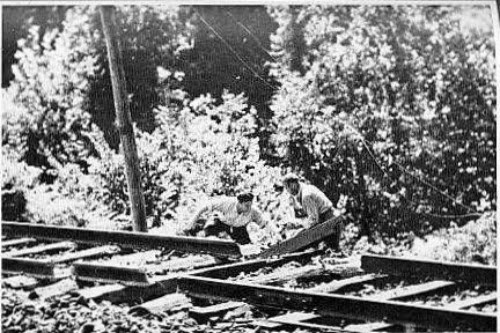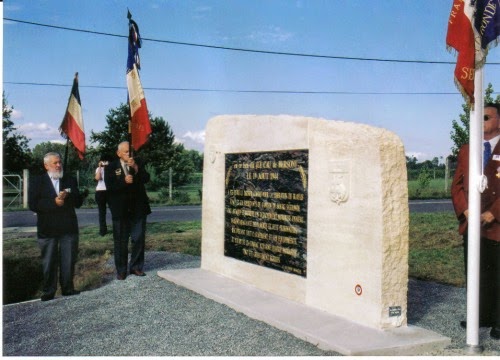When
we moved to France, one of the reasons was the great history of this region. It
was one of my intentions to research and write a little about medieval times in
the Aquitaine….Richard the Lionheart, Eleanor of Aquitaine just to name a
couple.
So
after a year in residence it surprises me to see my first writings are actually
not medieval but much more recent.
The
War years (WWII) were difficult times in France with the country divided
between the occupied Zone and The Free Zone (commonly known as Vichy
France). A quick look at the map below shows the two zones up to 1942,
after which the entire country effectively became occupied.
Sainte
Foy la Grande was in fact sitting on the border of the two zones with the
Dordogne River being used as part of that border.
From
the outset of the war, it was obvious that the Reich were very anti-Semitic. In
1939-40 many displaced people (mainly Jews) were sent from Alsace-Lorraine to
the Dordogne/Gironde Departments and Sainte Foy was one of the major centres. In
total 796 refugees were settled in Sainte Foy , 850 at Port Sainte Foy and a
further 506 at Pineuilh. Before this forced migration there was only one Jewish
family living in the area. As this was within the borders of Vichy France all
was well for the population until November 1942 when the Wehrmacht occupied all
of France.
While
there was no permanent garrison in Sainte Foy, there was however a temporary
Kommandatur based there. From this point, many brutal raids were carried out
against the local civilians and resistance, including the Jewish population.
In
the latter part of the war, the Resistance or the Maquis as they were known in France were quite active striking in
their own small ways at the German troops and the local infrastructure in
preparation for the impending allied invasion of France. Locals have told us
that the bridge (100 metres from our home was blown up and to ensure access to
the north, the Germans drove many trucks into and across the river and then
built a temporary bridge to facilitate a crossing.
Towards
the end of 1943, the mayor of Sainte Foy reportedly gave German authorities a
list of the names of Jews living in the town. Many of the families start moving
south towards the Spanish border, but others remain, some hidden by other local
residents and given false names. In March 1944, German troops and militiamen regularly
patrol the streets of Sainte Foy, but it was not until August 1944 that the “Battle
of Sainte Foy” saw a very strong attack on the local resistance.
 |
| The Maquis at work |
On
4 August 1944 a detachment of french collaborators dressed in German uniforms
capture six Jews in the town and the next day they are found massacred in the
woods in the nearby town of Le Fleix. Even the mayor of neighbouring St Andre
et Appelles was arrested and shot in Bergerac.
On
16 August, 1944 six members of the maquis were killed during clashes with
German troops. They included; Yves Delage (24 years), Arthur Eymerie (36), Yves
Baillard (24), Claude Michel Augé (20) and Andre Lavaud (23). The Germans even
dynamited the house of the local leader of the Maquis on 17 August 1944. His
house was next door to the local German headquarters. No doubt there were
others who were killed during these clashes but these are the instances that
were easy to find. These clashes all occurred on the streets that we walk
through every day.
 |
| Commemorating the dynamiting of the leader's house |
One
of the respected members of the resistance in the area was Ginette Marois who was born on 19 July, 1920. She was orphaned at
the age of 7 with her brother, raised by foster family and put through primary
school by the Sisters of St Joseph and then with scholarship for her secondary
education. She became a teacher and taught locally in the early 1940’s.
In
1941 at the age of 21 she joined the resistance via the University of Bordeaux.
She operated for many years under the pseudonym of “Simone” and in the early years she acted principally as a courier
between various resistance groups in the area between Castillon La Bataille and
Sainte Foy. While her early courier work was carried out as part of the Student
Union once the “Youth Battalions” were dismantled she managed to reach the
Southern Zone and joined the fighting units of the FTP ( Francs-tireurs partisans).
As
liberation approached, she became an Intelligence officer in the FTP and
participated in all fighting missions. On 15 August, during the Battle of
Sainte Foy, she managed during a conflict with a German convoy between Le Fleix
and Sainte Foy, to recover the documents of a German officer killed and their
weapons convoy for the Resistance. She managed to escape a German reprisal by
swimming across the Dordogne River to the Northern Zone.
As
the war was coming to an end, she was chosen as the only woman to speak on
behalf of the women of the resistance. Indeed on 6 September, 1944 she was
placed at the head of a parade of six thousand resistance fighters.
 |
| Commemorating the role of the Resistance......every year. |
While
it may not be as colourful as the medieval history of our area, it is all
brought home when you walk around the streets and find these little stone
monuments reminding us of some of the sacrifices made during the war. You can even still see some bullet holes.
 |
| A memorial in one of our local streets |
I will be back next time with some Medieval adventures.












